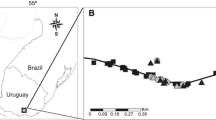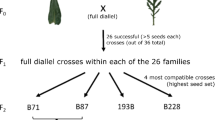Abstract
Hybrid zones between two species can reflect the combined effects of gene flow, genetic novelty, selection, and isolation barriers. Leucosceptrum japonicum and L. stellipilum are two morphologically distinct species belonging to Lamiaceae, which are endemic to Japan with partially overlapping distributions. In the present study, morphological and genetic variation in 11 populations in a putative hybrid zone between L. japonicum and L. stellipilum were investigated. No introgression was observed in the sympatric parental populations based on the cpDNA haplotype. Morphological intermediacy, ITS additivity and reduced pollen fertility confirmed the occurrence of hybridization between L. japonicum and L. stellipilum. Hybrid individuals appear to be not only early hybrid generation, but also advanced hybrid generation and/or backcross hybrids. The morphology of the putative early hybrid generation was too variable to distinguish all these hybrids from the parental species. The factors that facilitated and maintained hybridization between L. japonicum and L. stellipilum are discussed.







Similar content being viewed by others
References
Anderson E (1948) Hybridization of the habitat. Evolution 2:1–9
Anderson E, Stebbins GL (1954) Hybridization as an evolutionary stimulus. Evolution 8:378–388
Arnold ML (1993) Iris nelsonii (Iridaceae): origin and genetic composition of a homoploid hybrid species. Amer J Bot 80:577–583
Arnold ML (1997) Natural hybridization and evolution. Oxford University Press, New York
Arnold ML, Ballerini ES, Brothers AN (2012) Hybrid fitness, adaptation and evolutionary diversification: lessons learned from Louisiana Irises. Heredity 108:159–166
Baker HG (1947) Criteria of hybridity. Nature 159:546
Baldwin BG, Sanderson MJ, Porter MJ, Wojciechowski MF, Campbell CS, Donoghue MJ (1995) The ITS region of nuclear ribosomal DNA: a valuable source of evidence on angiosperm phylogeny. Ann Missouri Bot Gard 82:247–277
Barton NH (2001) The role of hybridization in evolution. Mol Ecol 10:551–568
Barton NH, Hewitt GM (1985) Analysis of hybrid zones. Ann Rev Ecol Syst 16:113–148
Bureš P, Šmarda P, Rotreklová O, Oberreiter M, Burešová M, Konečný J, Knoll A, Fajmon K, Šmerda J (2010) Pollen viability and natural hybridization of Central European species of Cirsium. Preslia 82:391–422
Campbell DR, Waser NM, Pederson GT (2002) Predicting patterns of mating and potential hybridization from pollinator behavior. Am Nat 159:438–450
Carine MA, Robba L, Little R, Russell S, Guerra AS (2007) Molecular and morphological evidence for hybridization between endemic Canary Island Convolvulus. Bot J Linn Soc 154:187–204
Chase MW, Salamin N, Wilkinson M, Dunwell JM, Kesanakurthi RP, Haidar N, Savolainen V (2005) Land plants and DNA barcodes: short-term and long-term goals. Philos Trans R Soc Lond B Biol Sci 360:1889–1895
Comes HP, Kadereit JW (1998) The effect of quaternary climatic changes on plant distribution and evolution. Trends Plant Sci 3:432–438
Dasmahapatra KK, Mallet J (2006) Taxonomy: DNA barcodes: recent successes and future prospects. Heredity 97:254–255
Dobzhansky TG (1937) Genetics and the origin of species. Columbia University Press, New York
Durrett R, Buttel L, Harrison R (2000) Spatial models for hybrid zones. Heredity 84:9–19
Egan SP, Funk DJ (2009) Ecologically dependent postmating isolation between sympatric host forms of Neochlamisus bebbianae leaf beetles. Proc Natl Acad Sci USA 106:19426–19431
Ellstrand NC, Whitkus R, Rieseberg LH (1996) Distribution of spontaneous plant hybrids. Proc Natl Acad Sci USA 93:5090–5093
Emms SK, Arnold ML (2000) Site-to-site differences in pollinator visitation patterns in a Louisiana iris hybrid zone. Oikos 91:568–578
Endler JA (1977) Geographic variation, speciation, and clines. Princeton University Press, Princeton
Feliner GN, Rosselló JA (2007) Better the devil you know? Guidelines for insightful utilization of nrDNA ITS in species-level evolutionary studies in plants. Mol Phylogen Evol 44:911–919
Fuertes Aguilar J, Rosselló JA, Nieto Feliner G (1999) Nuclear ribosomal DNA (nrDNA) concerted evolution in natural and artificial hybrids of Armeria (Plumbaginaceae). Mol Ecol 8:1341–1346
Funamoto T, Ogawa M (2004) A comparative study in cytological characters of Japanese species of Leucosceptrum, Lamiaceae (Labiatae). Chromosome Sci 8:109–113
Galbany-Casals M, Carnicero-Campmany P, Blanco-Moreno JM, Smissen RD (2012) Morphological and genetic evidence of contemporary intersectional hybridisation in Mediterranean Helichrysum (Asteraceae, Gnaphalieae). Plant Biol 14:789–800
Gower JC (1971) A general coefficient of similarity and some of its properties. Biometrics 27:857–871
Hall TA (1999) BioEdit: a user-friendly biological sequence alignment editor and analysis program for Windows 95/98/NT. Nucl Acid Symp 41:95–98
Hamilton MB (1999) Four primer pairs for the amplification of chloroplast intergenic regions with intraspecific variation. Mol Ecol 8:521–523
Hamilton JA, Aitken SN (2013) Genetic and morphological structure of a spruce hybrid (Picea sitchensis × P. glauca) zone along a climatic gradient. Am J Bot 100:1651–1662
Hardig TM, Brunsfeld SJ, Fritz RS, Morgan M, Orians CM (2000) Morphological and molecular evidence for hybridization and introgression in a willow (Salix) hybrid zone. Mol Ecol 9:9–24
Hewitt GM (1988) Hybrid zones-natural laboratories for evolutionary studies. Trends Ecol Evol 3:158–167
Kearns CA, Inouye DW (1993) Techniques for pollination biologists. University Press of Colorado, Niwot
Kikuchi R, Jae-Hong P, Takahashi H, Maki M (2010) Disjunct distribution of chloroplast DNA haplotypes in the understory perennial Veratrum album ssp. oxysepalum (Melanthiaceae) in Japan as a result of ancient introgression. New Phytol 188:879–891
Koch MA, Dobes C, Mitchell-Olds T (2003) Multiple hybrid formation in natural populations: concerted evolution of the internal transcribed spacer of nuclear ribosomal DNA (ITS) in North American Arabis divaricarpa (Brassicaceae). Mol Biol Evol 20:338–350
Lihová J, Kučera J, Perný M, Marhold K (2007) Hybridization between two polyploid Cardamine (Brassicaceae) species in north-western Spain: discordance between morphological and genetic variation patterns. Ann Bot (Oxford) 99:1083–1096
Maki M, Horie S (1999) Random amplified polymorphic DNA (RAPD) markers reveal less genetic variation in the endangered plant Cerastium fischerianum var. molle than in the widespread conspecific C. fischerianum var. fischerianum (Caryophyllaceae). Mol Ecol 8:145–150
Mallet J (2005) Hybridization as an invasion of the genome. Trends Ecol Evol 20:229–237
Mallet J (2007) Hybrid speciation. Nature 446:279–283
Marhold K, Lihová J (2006) Polyploidy, hybridization and reticulate evolution: lessons from the Brassicaceae. Pl Syst Evol 259:143–174
Meyer A (1987) Phenotypic plasticity and heterochrony in Cichlasoma managuense (Pisces, Chichlidae) and their implications for speciation in cichlid fishes. Evolution 41:1357–1369
Murata G, Yamazaki T (1993) Leucosceptrum Smith. In: Iwatsuki K, Yamazaki T (eds) Flora of Japan. Kodansha Ltd, Tokyo, pp 84–85
Oxelman B, Lidén M, Berglund D (1997) Chloroplast rps16 intron phylogeny of the tribe Sileneae (Caryophyllaceae). Pl Syst Evol 206:393–410
Peñaloza-Ramirez JM, González-Rodriguez A, Mendoza-Cuenca L, Caron H, Kremer A, Oyama K (2010) Interspecific gene flow in a multispecies oak hybrid zone in the Sierra Tarahumara of Mexico. Ann Bot (Oxford) 105:389–399
Petit RJ, Csaikl UM, Bordács S, Burg K, Coart E, Cottrell J, van Dam B, Deans JD, Dumolin-Lapègue S, Fineschi S, Finkeldey R, Gillies A, Glaz I, Goicoechea PG, Jensen JS, König AO, Lowe AJ, Madsen SF, Mátyás G, Munro RC, Olalde M, Pemonge M, Popescu F, Slade D, Tabbener H, Taurchini D, de Vries SGM, Ziegenhagen B, Kremer A (2002) Chloroplast DNA variation in European white oaks: phylogeography and patterns of diversity based on data from over 2600 populations. Forest Ecol Manag 156:5–26
Randell R, Howarth D, Morden C (2004) Genetic analysis of natural hybrids between endemic and alien Rubus (Rosaceae) species in Hawai`i. Conserv Genet 5:217–230
Rieseberg LH, Carney SE (1998) Plant hybridization. New Phytol 140:599–624
Rieseberg LH, Ellstrand NC (1993) What can molecular and morphological markers tell us about plant hybridization? Crit Rev Plant Sci 12:213–241
Rieseberg LH, Whitton J, Gardner K (1999) Hybrid zones and the genetic architecture of a barrier to gene flow between two sunflower species. Genetics 152:713–727
Shi S, Du Y, Boufford DE, Gong X, Huang Y, He H, Zhong Y (2003) Phylogenetic position of Schnabelia, a genus endemic to China: evidence from sequences of cpDNA matK gene and nrDNA ITS regions. Chin Sci Bull 48:1576–1580
Soltis PS, Soltis DE (2009) The role of hybridization in plant speciation. Annu Rev Plant Biol 60:561–588
Taberlet P, Gielly L, Pautou G, Bouvet J (1991) Universal primers for amplification of three non-coding regions of chloroplast DNA. Plant Mol Biol 17:1105–1109
Takahashi H (2001) A preliminary study on hybrids between Leucosceptrum stellatum and L. japonicum (Labiatae). Bull Soc Gifu Pref 17:95–101
R Development Core Team (2012) R: a language and environment for statistical computing. R Foundation for Statistical Computing, Vienna. http://www.r-project.org
Wendel JF, Schnabel A, Seelanan T (1995) An unusual ribosomal DNA sequence from Gossypium gossypioides reveals ancient, cryptic, intergenomic introgression. Mol Phylogen Evol 4:298–313
Widmer A, Baltisberger M (1999) Molecular evidence for allopolyploid speciation and a single origin of the narrow endemic Draba ladina (Brassicaceae). Amer J Bot 86:1282–1289
Wilson P (1992) On inferring hybridity from morphological intermediacy. Taxon 41:11–23
Winter P, Kahl G (1995) Molecular marker technologies for plant improvement. World J Microb Biotechnol 11:438–448
Wolfe AD, Xiang QY, Kephart SR (1998) Diploid hybrid speciation in Penstemon (Scrophulariaceae). Proc Natl Acad Sci USA 95:5112–5115
Wu CA, Campbell DR (2005) Cytoplasmic and nuclear markers reveal contrasting patterns of spatial genetic structure in a natural Ipomopsis hybrid zone. Mol Ecol 14:781–792
Acknowledgments
This study was partly supported by a Grant-in-Aid from the Japan Society for the Promotion of Science to MM. We are grateful to the following for their efforts in sampling, comments, and technical advice: S. Horie, T. Yamada, K. Yonekura, Y. Tsujita, Y. Sakamoto and K. Shimizu. We also thank the anonymous reviewers for helpful comments on the manuscript. The stay of YL in Japan is supported by the China Scholarship Council.
Author information
Authors and Affiliations
Corresponding author
Additional information
Y. Li and T. Itoi contributed equally to this work.
Electronic supplementary material
Below is the link to the electronic supplementary material.
Rights and permissions
About this article
Cite this article
Li, Y., Itoi, T., Takahashi, H. et al. Morphological and genetic variation in populations in a hybrid zone between Leucosceptrum japonicum and L. stellipilum (Lamiaceae) in the central Japanese mainland. Plant Syst Evol 301, 1029–1041 (2015). https://doi.org/10.1007/s00606-014-1134-5
Received:
Accepted:
Published:
Issue Date:
DOI: https://doi.org/10.1007/s00606-014-1134-5




